Raman Study of 532-Nanometer Laser-Induced Degradation of Red Lead
Abstract
1. Introduction
2. Materials and Methods
2.1. Materials
2.2. Instruments
2.3. The Design of the Experiment
3. Results
3.1. The Stokes Raman Spectra of Red Lead and β-PbO Excited by 532 nm and 785 nm Lasers
3.2. The In Situ Temperature Estimated by the Raman Spectra under Different Laser Power Densities
4. Discussion
5. Conclusions
Supplementary Materials
Author Contributions
Funding
Institutional Review Board Statement
Informed Consent Statement
Data Availability Statement
Conflicts of Interest
References
- Terpstra, H.J.; Groot, R.; Haas, C. The electronic structure of the mixed valence compound Pb3O4. J. Phys. Chem. Solids 1997, 58, 561. [Google Scholar] [CrossRef]
- Lauwers, D.; Cattersel, V.; Vandamme, L.; Van Eester, A.; De Langhe, K.; Moens, L.; Vandenabeele, P. Pigment identification of an illuminated mediaeval manuscript De Civitate Dei by means of a portable Raman equipment. J. Raman Spectrosc. 2014, 45, 1266. [Google Scholar] [CrossRef]
- Pięta, E.; Proniewicz, E.; Szmelter-Fausek, B.; Olszewska-Świetlik, J.; Proniewicz, L.M. Micro-Raman spectroscopy analysis of the 17th century panel painting ‘Servilius Appius’ by Isaac van den Blocke. J. Raman Spectrosc. 2014, 45, 1019. [Google Scholar] [CrossRef]
- Li, Y.; Wang, F.; Ma, J.; He, K.; Zhang, M. Study on the pigments of Chinese architectural colored drawings in the Altar of Agriculture (Beijing, China) by portable Raman spectroscopy and ED-XRF spectrometers. Vib. Spectrosc. 2021, 116, 103291. [Google Scholar] [CrossRef]
- Aze, S.; Delaporte, P.; Vallet, J.M.; Detalle, V.; Grauby, O.; Baronnet, A. Towards the restoration of darkened red lead containing mural paintings: A preliminary study of the beta-PbO2 to Pb3O4 reversion by laser irradiation. In Proceedings of the 7th International Conference on Lasers in the Conservation of Artworks, Madrid, Spain, 17–21 September 2007; p. 11. [Google Scholar]
- Aze, S.; Vallet, J.M.; Detalle, V.; Grauby, O.; Baronnet, A. Chromatic alterations of red lead pigments in artworks: A review. Phase Transit. 2008, 81, 145. [Google Scholar] [CrossRef]
- Burgio, L.; Clark, R.; Firth, S. Raman spectroscopy as a means for the identification of plattnerite (PbO2), of lead pigments and of their degradation products. Analyst 2001, 126, 222–227. [Google Scholar] [CrossRef] [PubMed]
- Costantini, I.; Lottici, P.P.; Castro, K.; Madariaga, J.M. Use of Temperature Controlled Stage Confocal Raman Microscopy to Study Phase Transition of Lead Dioxide (Plattnerite). Minerals 2020, 10, 468. [Google Scholar] [CrossRef]
- Handy, R.M.; Scala, L.C. Equilibrium Pressures of Oxygen over Oxides of Lead at Various Temperatures. J. Electrochem. Soc. 1966, 113, 525. [Google Scholar]
- Khorasani, M.; Gibson, I.; Ghasemi, A.H.; Hadavi, E.; Rolfe, B. Laser subtractive and laser powder bed fusion of metals: Review of process and production features. Rapid Prototyp. J. 2023, 29, 935. [Google Scholar] [CrossRef]
- Risold, D.; Nagata, J.; Suzuki, O. Thermodynamic description of the Pb-O system. J. Phase Equilibria 1998, 19, 213–233. [Google Scholar] [CrossRef]
- Surhone, L.M.; Tennoe, M.T.; Henssonow, S.F. Photochemical Reaction; John Wiley & Sons, Inc.: Hoboken, NJ, USA, 2013; p. 41. [Google Scholar]
- Rassat, S.D.; Davis, E.J. Temperature Measurement of Single Levitated Microparticles Using Stokes/Anti-Stokes Raman Intensity Ratios. Appl. Spectrosc. 1994, 48, 1498–1505. [Google Scholar] [CrossRef]
- Malyj, M.; Griffiths, J.E. Stokes/Anti-Stokes Raman Vibrational Temperatures: Reference Materials, Standard Lamps, and Spectrophotometric Calibrations. Appl. Spectrosc. 2016, 37, 315–333. [Google Scholar] [CrossRef]
- Mcgrane, S.D.; Aslam, T.D.; Pierce, T.H.; Hare, S.J.; Byers, M.E. Temperature of shocked plastic bonded explosive PBX 9502 measured with spontaneous Stokes/anti-Stokes Raman. J. Appl. Phys. 2018, 123, 045902. [Google Scholar] [CrossRef]
- Millar, R.W. The heat capaticities at low temprature of the oxides of Tin and Lead. J. Am. Chem. Soc. 1935, 51, 207. [Google Scholar] [CrossRef]
- Mattei, E.; Vivo, G.D.; Santis, A.D.; Gaetani, C.; Pelosi, C.; Santamaria, U. Raman spectroscopic analysis of azurite blackening. J. Raman Spectrosc. 2010, 39, 302. [Google Scholar] [CrossRef]
- Mccann, L.I.; Trentelman, K.; Golding, B.P. Corrosion of ancient Chinese bronze money trees studied by Raman microscopy. J. Raman Spectrosc. 1999, 30, 121–132. [Google Scholar] [CrossRef]
- Hanna, D.; Luther-Davies, B.; Rutt, H.; Smith, R.; Stanley, C. Q-switched laser damage of infrared nonlinear materials. IEEE J. Quantum Electron. 2003, 8, 317. [Google Scholar] [CrossRef]
- Wu, F.R.; Zhang, Y.K.; Li, Y.; Wang, Y.H.; Ma, J.J.; Wang, F.P. Photoinduced effects of monochromatic visible light with different wavelengths on realgar. J. Raman Spectrosc. 2022, 53, 1533. [Google Scholar] [CrossRef]
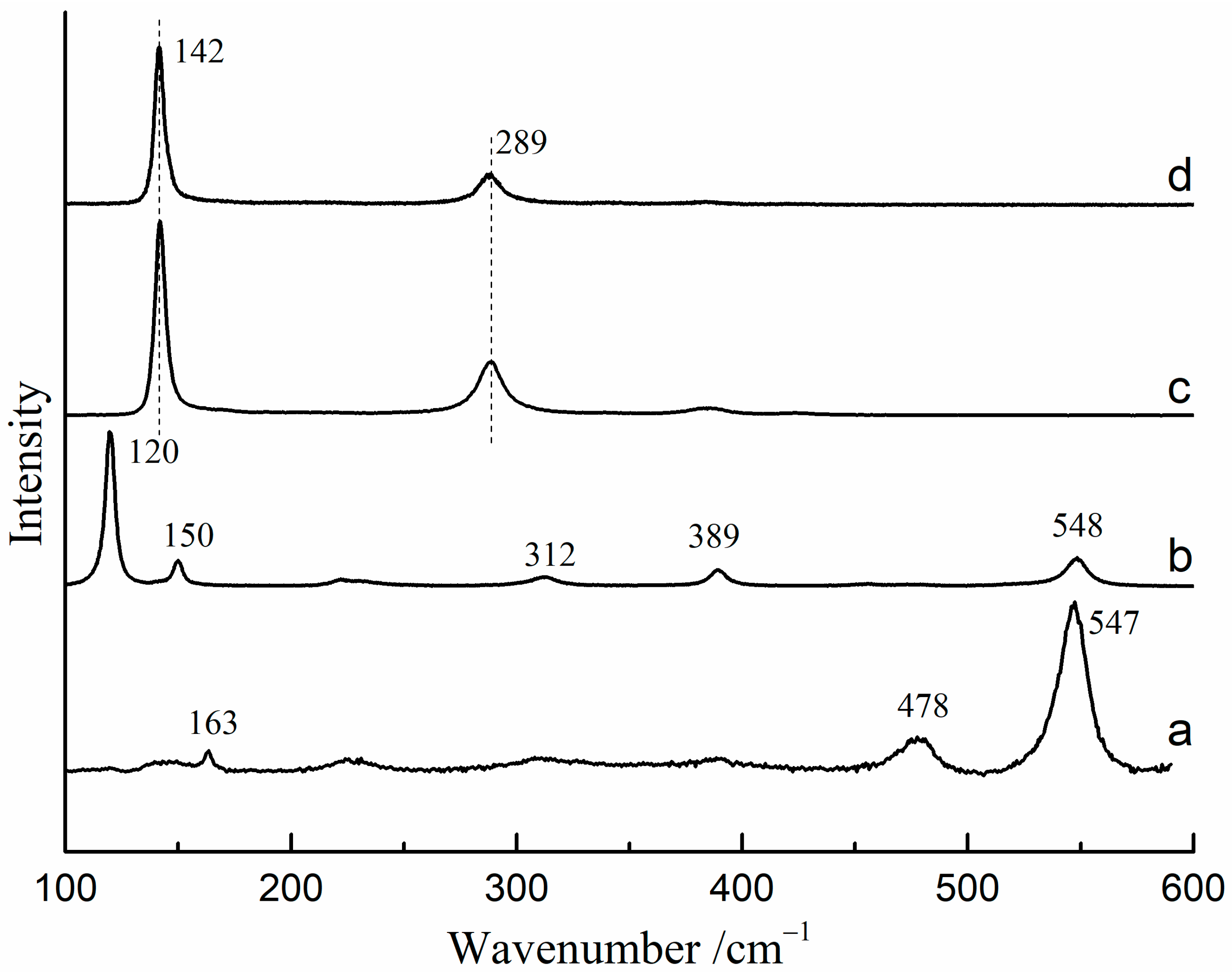


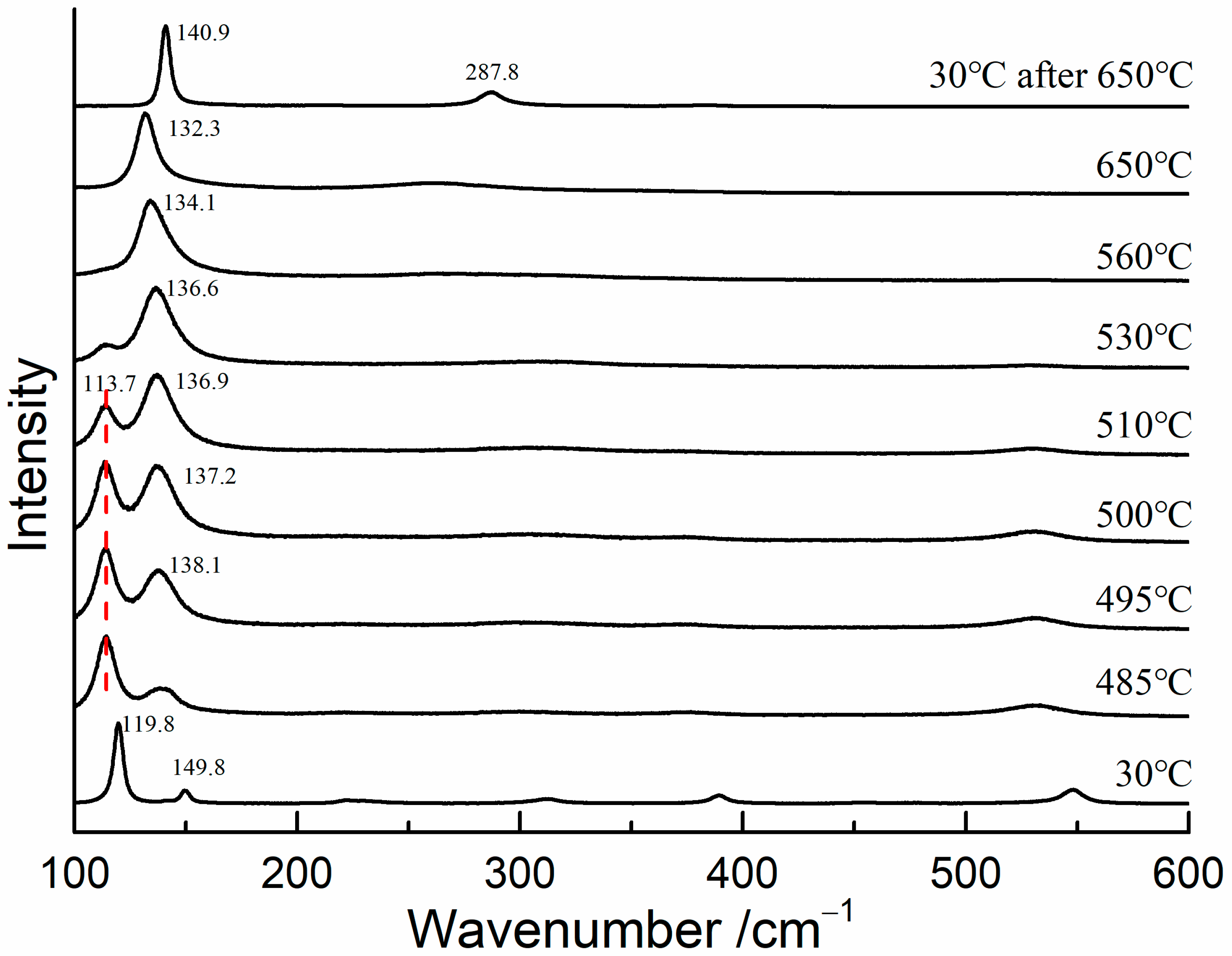
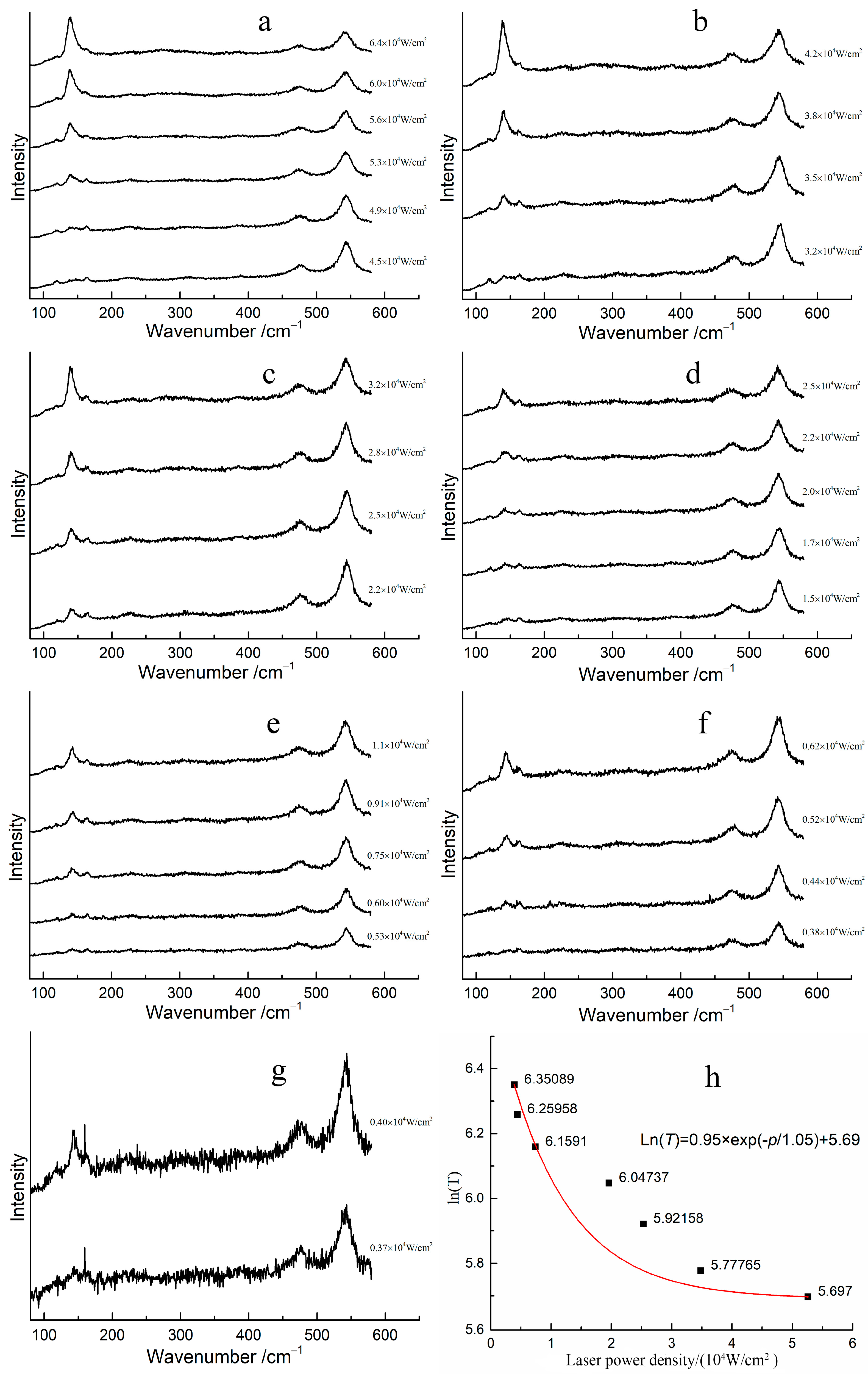
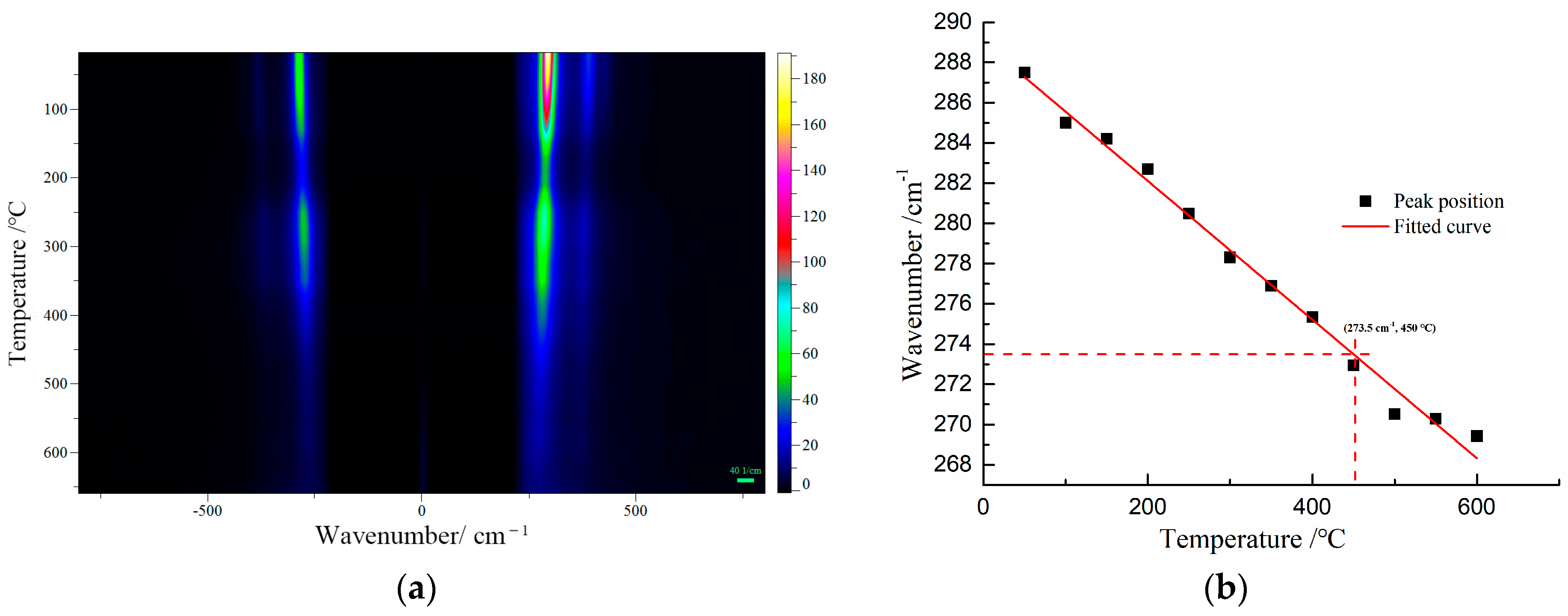
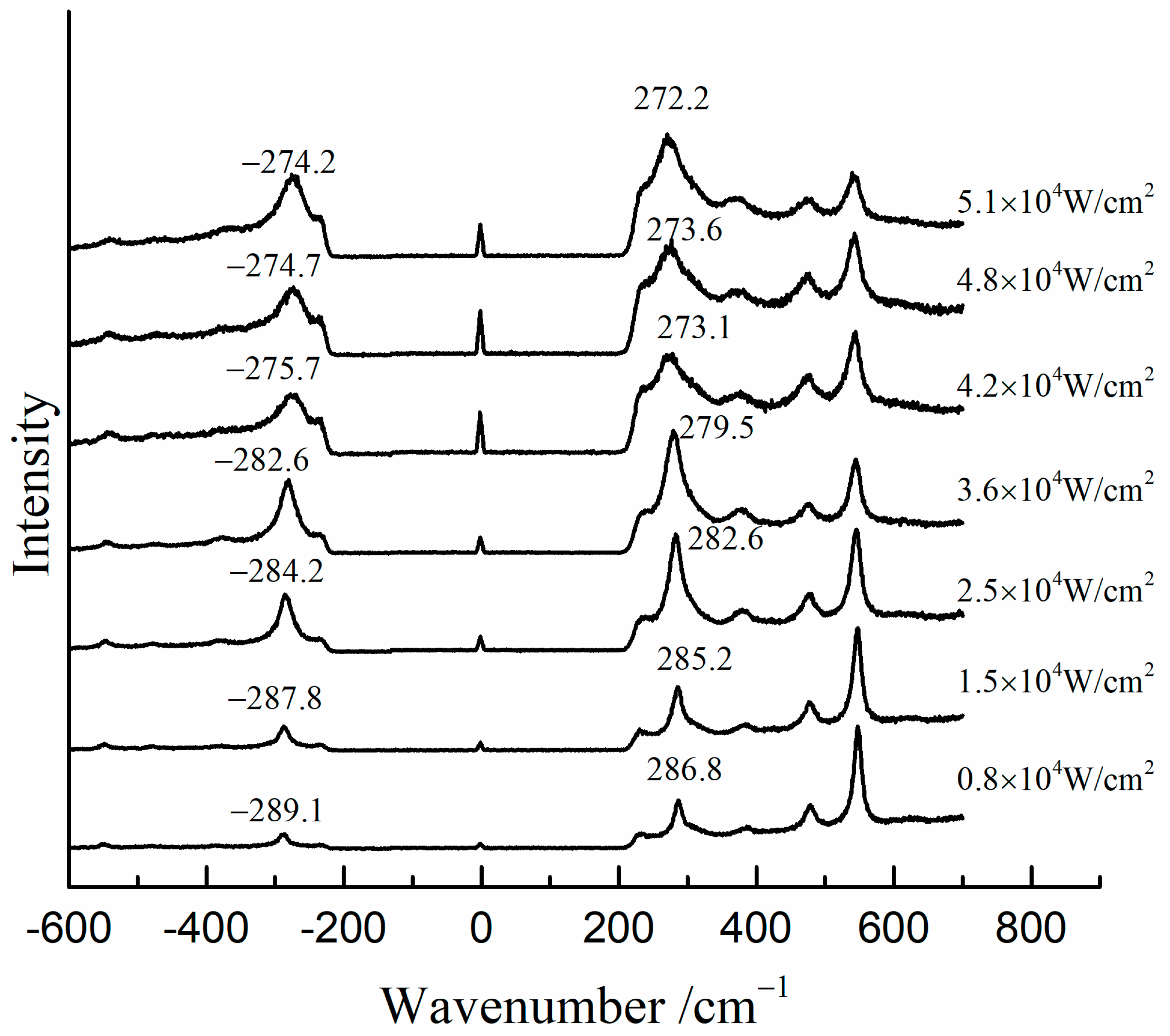

| Step 1 | Step 2 | Step 3 | Step 4 | Step 5 | Step 6 | Step 7 | |
|---|---|---|---|---|---|---|---|
| Material | Red lead, β-PbO | Red lead | Red lead | Red lead | Red lead | β-PbO | Mixture (Red lead, β-PbO) |
| Temperature/°C | 22 | 22 | 22 | 30~650 | 30~300 | 30~600 | 22 |
| Laser power density/104 W/cm2 | 2.3 (532 nm) | 3.2~5.4 | 3.2~4.2 | 0.37~6.4 | 0.53~1.1 | 0.34~0.62 | |
| Excitation wavelength | 532 nm 785 nm | 532 nm | 532 nm | 785 nm | 532 nm | 532 nm | 532 nm |
| Samples | Thermal Diffusivity (mm2/s) | Density (g/cm3) | Specific Heat Capacity (J/(kg·K)) [16] | Thermal Conductivity (W/(m·K)) |
|---|---|---|---|---|
| Red lead | 0.039 | 9.30 | 210 | 0.076 |
| β-PbO | 0.068 | 8.74 | 200 | 0.118 |
Disclaimer/Publisher’s Note: The statements, opinions and data contained in all publications are solely those of the individual author(s) and contributor(s) and not of MDPI and/or the editor(s). MDPI and/or the editor(s) disclaim responsibility for any injury to people or property resulting from any ideas, methods, instructions or products referred to in the content. |
© 2024 by the authors. Licensee MDPI, Basel, Switzerland. This article is an open access article distributed under the terms and conditions of the Creative Commons Attribution (CC BY) license (https://creativecommons.org/licenses/by/4.0/).
Share and Cite
Li, Y.; Ma, J.; He, K.; Wang, F. Raman Study of 532-Nanometer Laser-Induced Degradation of Red Lead. Materials 2024, 17, 770. https://doi.org/10.3390/ma17040770
Li Y, Ma J, He K, Wang F. Raman Study of 532-Nanometer Laser-Induced Degradation of Red Lead. Materials. 2024; 17(4):770. https://doi.org/10.3390/ma17040770
Chicago/Turabian StyleLi, Yan, Junjie Ma, Kang He, and Fengping Wang. 2024. "Raman Study of 532-Nanometer Laser-Induced Degradation of Red Lead" Materials 17, no. 4: 770. https://doi.org/10.3390/ma17040770
APA StyleLi, Y., Ma, J., He, K., & Wang, F. (2024). Raman Study of 532-Nanometer Laser-Induced Degradation of Red Lead. Materials, 17(4), 770. https://doi.org/10.3390/ma17040770






